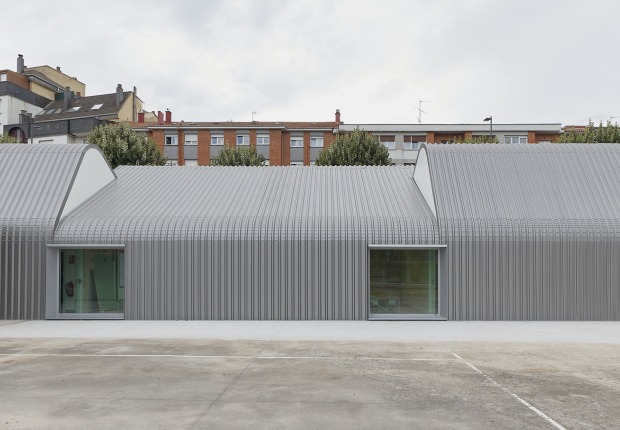Theodora House is a mixed-use building consisting of several apartment typologies as well as an office wing. Part of the building complex is built as new construction, and part of it is a transformation of a former yeast storage building that used to fill the entire building plot.
Project description by ADEPT
The historic Carlsberg Brewery site in Copenhagen has opened to the public to become part of the city - and is now seriously embarking on the successful transformation to a dense urban neighborhood of its own, the Carlsberg City.
Transforming many of the preserved buildings, designed by some of the best European architects of the era, the new neighborhood is at the same time a unique cultural-historical environment and an attractive modern district. New images by Rasmus Hjortshoj shows ADEPTs contribution to the area - Theodora House - shot in a corona-closed Copenhagen.
Theodora House, named after the Carlsberg founder’s daughter, is located right beside the famous Elephants Gate and adapted in materials and scale to its historic surroundings. Part of the building complex is new construction and part of it is the re-use of former yeast storage that used to fill the plot.
Only one wing of the storage was preservable and now occupied by office spaces overlooking one of Carlsberg City’s small plazas. The new part of the building is mainly apartments but where it meets the street and plazas is has spaces for shops and cafés.
Theodora House emphasizes the complex character of Carlsberg with facades reflecting local history. Walking around the building it is obvious that it ‘absorbs’ the various brick expressions in the area – making it stand out as both its own and carefully adapted to the neighborhood.
The original façade of the Yeast Storage has been preserved. Transition to the new part of the building is carefully handled through the Elephants Gate. The new brick was selected to respect the existing, yet make a modern statement.
The curved brick that identifies the facade to the North was designed for the building in close collaboration with the brick manufacturer. The curves give a varied play of texture that gradient towards the roof.
The gates facing the street show motives from the history of the Yeast Storage. The inner courtyard makes a strong contrast to the brick facades, and here, in time, green walls will embrace a small resident’s garden.
Interview with ADEPT
1) How is the building designed to complement the existing buildings on the site?
The Carlsberg Brewery site has always been characterized by a very strong brick identity and this identity has been part of the requirements in the masterplan for the new neighborhood from the beginning. The buildings in the area are a mix of historic buildings transformed into modern purposes as well as new residential complexes, office spaces, and public functions. We wanted to create a design that was almost zipped together with the historic buildings in material, color, and texture – and told a story of what came before, yet had given its modern impression in detail and architecture.
2) How does the brickwork reflect the area’s history?
The creative use of brick decorations in the facades is very common in the Carlsberg City, both in the historic buildings from the 1800 – 19000 and in modern additions to the complex like the quite amazing Hanging Gardens by Svenn Eske Kristensen from the 1960s. We like to think that Theodora House carries this tradition forward.
3) How and why are curved bricks incorporated in the design?
The listed front of the former Yeast Storage with its characteristic clock tower that forms part of Theodora House is super detailed in its brickwork. An almost flourish pattern is dotted all over the East façade. We wanted to create a modern pendant to this kind of historic decoration and make it an integrated element instead of merely a way of laying bond and mortar.
4) How did you negotiate to design a building to stand alongside a giant elephant on such an important site?
The Elephants Gate is the historic entrance of the Carlsberg Brewery and a beloved Copenhagen landmark. The Yeast Storage that lined it was only partly listed, the façade to the East now part of the office wing of Theodora House. The main volume of the storage was not suitable for reuse and had to be demolished. The Carlsberg City masterplan makes sure that the plots are designed by different architects to ensure diversity, a huge quality in the plan – and we were lucky enough to be chosen for this unique site.
5) Why are the internal (courtyard) and external facades treated so differently?
Carlsberg City is a very homogeneous urban plan, the primarily redish brick facades makes for a very strong and coherent character. The landscape of the inner courtyard of Theodora House is designed by WERK that also did many of the surrounding plazas close by. They designed the landscape as a small gem, semi-accessible to the public and we wanted the interior façade to reflect the thought of this hidden oasis in the city. The geometric patterns of the facades will in time be green with plants that climb the wooden trellises - and the overall impression will then be much more garden-like.
6) How many apartments are in the block, how much office space, how many shops and retail units.
Area:
3,100 m² parking
4,130 m² office
4,350 m² residential
The rest of the areas are common spaces, bike parking, storage, etc.
Ground floor:
1 restaurant
1 Café
3 shops
4 large office spaces in the transformed Yeast Storage building
58 apartments

























































